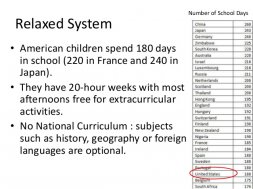First, the youngest students, when they’re children, can go to school starting at about 4 years old, and that would be preschool. In most places those are not public, they’re not free, so one would have to pay to send their child to preschool. And then there’s kindergarten, and in most places, that is public and that is free, so families can send their children there. And then, everywhere, at 6 years old, 1st grade starts, and that’s public, there’s a public option. You can also of course send your child to private school. So from 1st grade to 5th grade, that’s primary school, or elementary school is the other name for it. And there are private and public versions. And after that, there is middle school, often called junior high school, which is grade 6th through 8th, and that is from about 12 years old to 14 years old. And then high school, 14 years old to 18 years old, 4 years there, and that also has public and private options.
You are required to go to school until you’re sixteen, and then you can drop out if you want.
In general, we have what is called a federal system, where there is a lot of power that States have, and then cities within states and even smaller municipalities within cities can make their own rules. And education is a good example of where it can really depend on where you are. The requirements can be very different from place to place and the type of schools that are offered can vary very much from state to state.
We have local departments of education, so New York for example has a department of education, and they appoint chancellors for example, that control, create guidelines, they have some sort of control over lots of different schools. Each school has a principal, and maybe several vice-principals, which govern the daily operations. And it can really be school by school how much they want to involve parents.
Because we have this federal system, and local communities basically can decide what sort of education they want to give students, there can be really very large differences in the education that you get in one part of the country or another. And sometimes that becomes a really big news story, for example in the teaching of evolution. So you can have a school board, and most notably and famously like in Kansas, that will decide that they do not want evolution taught in school. And they can do that ! Now of course that creates a lot of media buzz and attention, and often scorn and criticism, and they can react to that – but they have the right to do something as fundamental as alter science education. There are many examples of that. Arizona, for example, has decided to change their history education, so they can add and remove things to their history education. Which again, can be controversial, but they do have the right to do that. The federal government can’t tell them to do that, they are responding to their local constituencies as to what they include in their curriculum.
As far as I know, what the government can do – and they do this in many realms – is they can offer money and funding, and make that funding dependent on certain things that they want. So they can influence schools in that way. But they don’t tell states what to teach. There is no national standards.
The only national standard that we have is a really lose, non governmental one, which is that most colleges require the SAT or Standard Aptitude Test. So that ends up being something that is in the minds of all teachers and principals, everyone involved, that most students will have to take that test and do well on it, to go to the college that they want.
So there are several different types of colleges or university-level schools. They have very different names : some of them are called institutes, some of them are called colleges, some of them are called universities… But basically, after high school – they all require high school diploma or an equivalent. Many of them require the SATs, which is basically a test of math skills and reading skills, and also there can be this analytical or quantitative piece as well. So there’s this standardized national test, that these institutions look at. And they also look at your high school grades, and the other things that you’ve done : what we call “extracurricular activities.” Were you in the film club? Did you play sports? Did you do a lot of community service? Did you do an extra science project that won some award? There’s lot of different things. And the way the admission process works is really particular to the university or college in question. Everyone decides what their criteria are.












